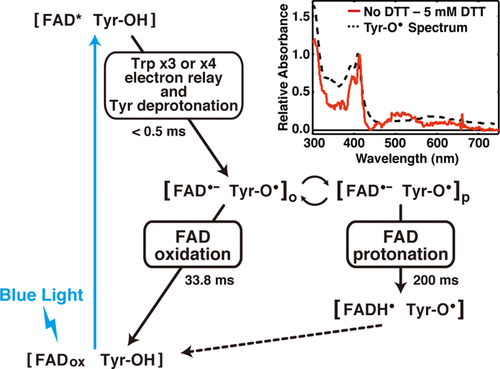当前位置:
X-MOL 学术
›
Biochemistry
›
论文详情
Our official English website, www.x-mol.net, welcomes your
feedback! (Note: you will need to create a separate account there.)
Rapid Oxidation Following Photoreduction in the Avian Cryptochrome4 Photocycle.
Biochemistry ( IF 2.9 ) Pub Date : 2020-09-11 , DOI: 10.1021/acs.biochem.0c00495 Hiroaki Otsuka 1 , Hiromasa Mitsui 1 , Kota Miura 1 , Keiko Okano 1 , Yasushi Imamoto 2 , Toshiyuki Okano 1
Biochemistry ( IF 2.9 ) Pub Date : 2020-09-11 , DOI: 10.1021/acs.biochem.0c00495 Hiroaki Otsuka 1 , Hiromasa Mitsui 1 , Kota Miura 1 , Keiko Okano 1 , Yasushi Imamoto 2 , Toshiyuki Okano 1
Affiliation

|
Avian magnetoreception is assumed to occur in the retina. Although its molecular mechanism is unclear, magnetic field-dependent formation and the stability of radical-containing photointermediate(s) are suggested to play key roles in a hypothesis called the radical pair mechanism. Chicken cryptochrome4 (cCRY4) has been identified as a candidate magnetoreceptive molecule due to its expression in the retina and its ability to form stable flavin neutral radicals (FADH●) upon blue light absorption. Herein, we used millisecond flash photolysis to investigate the cCRY4 photocycle, in both the presence and absence of dithiothreitol (DTT); detecting the anion radical form of FAD (FAD●–) under both conditions. Using spectral data obtained during flash photolysis and UV–visible photospectroscopy, we estimated the absolute absorbance spectra of the photointermediates, thus allowing us to decompose each spectrum into its individual components. Notably, in the absence of DTT, approximately 37% and 63% of FAD●– was oxidized to FADOX and protonated to form FADH●, respectively. Singular value decomposition analysis suggested the presence of two FAD●– molecular species, each of which was destined to be oxidized to FADOX or protonated to FADH●. A tyrosine neutral radical was also detected; however, it likely decayed concomitantly with the oxidation of FAD●–. On the basis of these results, we considered the occurrence of bifurcation prior to FAD●– generation, or during FAD●– oxidization, and discussed the potential role played by the tyrosine radical in the radical pair mechanism.
中文翻译:

在禽类Cryptochrome4 Photocycle中进行光还原后快速氧化。
禽的磁感受假定发生在视网膜中。尽管其分子机理尚不清楚,但据推测,磁场依赖性的形成和含自由基的光中间体的稳定性在称为自由基对机理的假设中起着关键作用。鸡隐花色素4(cCRY4)由于其在视网膜中的表达以及在吸收蓝光后能够形成稳定的黄素中性自由基(FADH ●)的能力而被鉴定为候选磁感受分子。在本文中,我们在存在和不存在二硫苏糖醇(DTT)的情况下,使用毫秒级快速光解法研究了cCRY4光循环;检测FAD的阴离子自由基形式(FAD ●–)。利用在快速光解和紫外可见光光谱学中获得的光谱数据,我们估算了光中间体的绝对吸收光谱,从而使我们能够将每个光谱分解成其各个组成部分。值得注意的是,在没有DTT的情况下,大约37%和63%的FAD ●被氧化为FAD OX并质子化形成FADH ●。奇异值分解分析表明存在两种FAD ●分子,每种分子注定会被氧化为FAD OX或质子化为FADH ●。还检测到酪氨酸中性基团。但是,它可能会随着FAD的氧化而衰变●。根据这些结果,我们考虑了在FAD ●–生成之前或在FAD ●–氧化期间发生的分叉,并讨论了酪氨酸自由基在自由基对机理中的潜在作用。
更新日期:2020-09-29
中文翻译:

在禽类Cryptochrome4 Photocycle中进行光还原后快速氧化。
禽的磁感受假定发生在视网膜中。尽管其分子机理尚不清楚,但据推测,磁场依赖性的形成和含自由基的光中间体的稳定性在称为自由基对机理的假设中起着关键作用。鸡隐花色素4(cCRY4)由于其在视网膜中的表达以及在吸收蓝光后能够形成稳定的黄素中性自由基(FADH ●)的能力而被鉴定为候选磁感受分子。在本文中,我们在存在和不存在二硫苏糖醇(DTT)的情况下,使用毫秒级快速光解法研究了cCRY4光循环;检测FAD的阴离子自由基形式(FAD ●–)。利用在快速光解和紫外可见光光谱学中获得的光谱数据,我们估算了光中间体的绝对吸收光谱,从而使我们能够将每个光谱分解成其各个组成部分。值得注意的是,在没有DTT的情况下,大约37%和63%的FAD ●被氧化为FAD OX并质子化形成FADH ●。奇异值分解分析表明存在两种FAD ●分子,每种分子注定会被氧化为FAD OX或质子化为FADH ●。还检测到酪氨酸中性基团。但是,它可能会随着FAD的氧化而衰变●。根据这些结果,我们考虑了在FAD ●–生成之前或在FAD ●–氧化期间发生的分叉,并讨论了酪氨酸自由基在自由基对机理中的潜在作用。











































 京公网安备 11010802027423号
京公网安备 11010802027423号